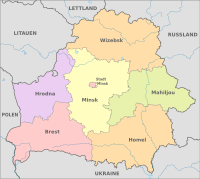Belarus
![]()
Belarus is a redirect to this article. For other meanings, see Belarus (disambiguation).
Template:Infobox State/Maintenance/TRANSCRIPTION
Template:Infobox State/Maintenance/NAME-German
Belarus, official short form Belarus [ˈbeːlaˌʁʊs]/[ˈbɛlaˌʁʊs] (Belarusian/Russian Беларусь resp. traditional Russian Белоруссия Belorussija; official full form: Рэспубліка Беларусь (Belarusian) resp. Республика Беларусь (Russian), German transcription Respublika Belarus [rɛspublʲika bʲɛlaˈrusʲ], German Republik Belarus), is a landlocked Eastern European country whose capital is Minsk. Belarus borders Lithuania, Latvia, Russia, Ukraine, and Poland. The dissolution of the Soviet Union in 1991 made the Belarusian Soviet Socialist Republic independent.
Since 1994, Alyaksandr Lukashenka (usually spelled Alexander Lukashenko in German-language media), has been the authoritarian and repressive president, making the country the last dictatorship in Europe. The allegedly rigged 2020 Belarus presidential election in August was followed by weeks of nationwide protests and strikes against the government. The demonstrations were put down with extreme brutality. The Office of the United Nations High Commissioner for Human Rights said it had received reports of over 450 documented cases of torture and ill-treatment.
Belarus is a full member of the Commonwealth of Independent States.
Geography
The largest extension of the country from west to east is 650 km - from north to south is 560 km. Among the European states, Belarus is the 13th in terms of area and the largest landlocked country located entirely in Europe.
The state borders with Russia and Ukraine each make up about 1000 km and a total of two thirds of the border, while Poland, Lithuania and Latvia account for the last third. The course of the border is irregular and follows only to Poland partially waters (Bug), but mainly the border runs over marshes and hills.
The distance from the capital Minsk to the capitals of neighboring states is:
- to Vilnius: 215 km
- to Riga: 470 km
- to Warsaw: 550 km
- to Kiev: 580 km
- to Moscow: 700 km
In the south lie the Prypyat swamps (Prypyazkija baloty in Belarusian). 30 percent of the country is forested. The highest elevation is the Dzjarschynskaja Hara (345 m) in the Belarusian Ridge, the lowest river valleys are about 50 meters above sea level.
Waters
Belarus lies in the East European Plain and is criss-crossed by chains of hills from the ice-age terminal moraines (Belarusian Ridge) and wide, natural rivers. About 70 percent of the country drains south to the Prypyat (Belarusian Prypyaz) and the Dnieper (Belarusian Dnipro), which flows further through Ukraine to the Black Sea. (See also: List of rivers in Belarus).
The largest rivers in Belarus are the Dnepr, Bjaresina, Prypjat and Memel (Belarusian Njoman). The Bug River is relevant as a border to Poland and thus to the EU. The largest lake is the Naratsch in the north of the country near the border with Lithuania.
See also: Lakes of Belarus
Environment
Belarus is most affected by the Chernobyl nuclear disaster (1986), which contaminated about 25 percent of the country's territory, especially in the east and south.
Management structure
Belarus is divided into six administrative regions (woblasts in Belarusian) with 118 districts (rajons). The capital Minsk has a special status and does not belong to any of the woblasts.
|
|
|
See also: List of rajons of Belarus
Largest cities
(Population as per estimate 1 January 2019)
- Minsk - 1,992,685
- Homel - 536,938
- Mahiljou - 383,313
- Vizebsk - 378,459
- Hrodna - 373,547
- Brest - 350,616
- Babruysk - 216,793
- Baranavichy - 179,000
- Baryssau - 142,681
- Pinsk - 137,960
- Orscha - 114,135
- Masyr - 112,348
- Salihorsk - 106,289
- Navapolazk - 101,125
- Lida - 101,928
- Maladzechna - 94,558
- Polazk - 84,332
- Schlobin - 76,234
- Svetlahorsk - 67,054
- Retschyza - 65,873
- Shodzina - 64,705
- Sluzk - 61,465
- Kobryn - 53,411
- Slonim - 49,338
- Waukawysk - 43,815
- Kalinkavichy - 40,203
- Smarhon - 37,528
- Rahachou - 34,447
- Horki - 34,332
- Assipovichy - 30,951
- Nawahrudak - 29,525
See also: List of cities in Belarus
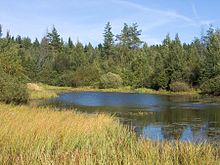
Swamp area near the Prypyat
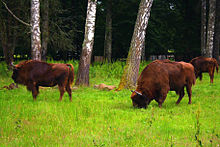
The bison, here in the Belavescha National Park, is considered the national animal of Belarus.
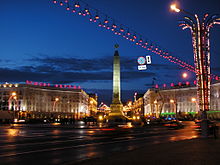
Victory Square in the capital Minsk
History
→ Main article: History of Belarus
Slavs
The region of Polesia, located in the south of Belarus, is considered a possible original homeland of the Slavs as a whole. In the early Middle Ages, most of what is now Belarus was inhabited by East Slavic tribes, including the Dregoviches, the Radimiches, and the Polochans. Baltic tribes lived in the northwest. The region became a part of the Kievan Empire, the first major East Slavic state. Its components on the territory of Belarus included the Principality of Polotsk and the Principality of Turov-Pinsk. By 1240, the Mongol invasion from the east destroyed Kievan Rus. By the 14th century, the Old Russian unity had disintegrated.
Development
Several ethnic groups emerged from Kievan Rus:
- The principality of Galicia-Volhynia, which stretched from the northern slopes of the Carpathians across what is now eastern Galicia and Volhynia, arose on the territory of present-day Ukraine. This realm existed until the middle of the 14th century and formed the foundation for the later Ukrainian ethnic group, but then fell under Lithuanian-Polish rule.
- On the territory of Belarus gradually formed the Belarusian ethnic group.
- Greater Russia fell under Mongol-Tatar rule until 1480, when it was able to break away from it under Moscow's leadership.
In the 14th century, however, the Belarusian territory with the principality of Smolensk and the principality of Polazk was conquered by the Grand Duchy of Lithuania, which expanded far to the east. Its ruler held the title magnus dux Littwanie, Samathie et Rusie (see also Golden Age (Belarus)). The two peoples (White Russians and Lithuanians) called themselves Lithuanians (lietuvis and litwin, respectively) in their languages. Because of the population proportions, the official language during this period was largely Ruthenian, an East Slavic language. After the Union of 1386, Belarus, as part of Lithuania, became part of the dual state of Poland-Lithuania, with which it remained until the end of the 18th century.
With the first and second partition of Poland, the territory of today's White Russia came completely under Russian rule by 1793, which was seen by the Russian side as a reunification. The annexation of White Rus was accomplished by Catherine the Great under the motto "Отторженная возвратихъ" - "I have taken back what was torn away".
From 1918 to 1990
After the invasion of the German army in Minsk in early 1918, the nominally independent Belarusian People's Republic existed for a time. This introduced women's suffrage in 1918.
The Rada of the Belarusian People's Republic is still active today and is one of the oldest governments in exile in the world. In 1919/1920, Belarus was contested between the re-established Polish state and Soviet Russia, and was partially annexed to Poland in 1920 after the victory of Polish troops over the Red Army. The Soviet part was formed into the Belarusian Soviet Socialist Republic, which became a founding member of the Soviet Union in 1922. Like the Soviet part, the Polish part was also majority Belarusian populated. In the Vossische Zeitung from 1929 there is a situation report about the country and its people under the headline: Grenzland unterm Sowjetstern, which focuses on the new national consciousness.
At the beginning of the Second World War, in 1939, as a result of the Molotov-Ribbentrop Pact concluded shortly before, the part of the country that had previously belonged to Poland was occupied by Soviet troops and incorporated into the Belarusian SSR. In the summer of 1941, all of Belarus was conquered by the Wehrmacht. The German occupation caused great material destruction and led to the death of about 25 percent of the population, including almost the entire Jewish population of the country. From 1941 onwards, Belarus was a major area of Soviet partisan struggle against the German occupiers, with over 1000 groups. During the German occupation, the Belarusian Central Council (Bielaruskaya Centralnaya Rada - BCR) was installed in Belarus, a puppet government that used historical Belarusian state emblems. The chairman of the BCR was Radasłaŭ Astroŭski. This "state" disappeared after the retreat of the German Eastern Front in 1944. From the end of 1943, the Red Army recaptured the country; it was considered completely liberated from German occupation in the summer of 1944.
About 8-9 percent of all murdered European Jews came from Belarus. Almost all the cities of the country were completely destroyed. Industrial enterprises had decreased by 85 percent, industrial capacity by 95 percent, seeded land by 40-50 percent, livestock by 80 percent. At the end of the war there were three million homeless. Before World War II, ten million people lived in Belarus. It was not until the late 1980s that the Belarusian population had grown back to these pre-war numbers.
The Belarusian SSR, like the Ukrainian SSR and the USSR, was a founding member of the United Nations in 1945.
Belarus was severely affected by the nuclear disaster in Chernobyl, Ukraine, on 26 April 1986, as a result of which large parts of the country were contaminated by radioactive fallout.
New independence
Since the end of 1991, the country is an independent state. From 1991 to 1994 it was ruled by Stanislav Shushkevich. He was succeeded by Alyaksandr Lukashenka, who has ruled dictatorially ever since. Lukashenka's policies are described by critics as undemocratic, authoritarian and anti-market, and the parliament has a purely decorative function. The country is severely isolated economically and politically in Europe. Its most important political and economic partners are Russia, Iran and Venezuela. A customs and defense community has been established with Russia, and a more far-reaching union with a common currency and common foreign policy has been announced repeatedly since the 1990s without much progress. All presidential elections since 2001 (9 September 2001, 19 March 2005, 19 December 2010, 11 October 2015 and 9 August 2020) have been described as undemocratic by numerous international observers. In 2020, the most promising opposition candidate, Svyatlana Zikhanouskaya, was massively intimidated before the election; she was forced to leave Belarus after the election. After the 2020 election, there were months of protests in Belarus despite massive state violence and thousands of arrests.
Protests after the presidential election in Belarus 2020
→ Main article: Protests in Belarus from 2020
In particular, in connection with the presidential election in 2020, there were violent protests and strikes directed against the proclamation of President Lukashenka as the renewed winner of the election. The country's leadership responded with arrests of some 6700 protesters and massive police violence. On September 7, Maria Kalesnikava, one of the three candidates, and on September 9, lawyer Maksim Snak, both leading members in the Coordinating Council of the protests, were kidnapped by masked men without license plates in the open street. It has since become known that they have been in pre-trial detention ever since. When Kalesnikava was to be deported to Ukraine, she successfully resisted by destroying her identity card. There are also diplomatic protests from EU states against the detention of the opposition members.
The opposition candidate Svyatlana Zikhanouskaya fled to Lithuania. A constitutional amendment was finally brought into play by President Lukashenka to counter the protests.
Forced landing of Ryanair flight 4978 in Minsk
→ Main article: Ryanair flight 4978
An incident that caused an international sensation occurred on May 23, 2021, when a passenger plane of the Irish airline Ryanair was intercepted. The plane, which was on its way from Athens to Vilnius, was forced to land at Minsk airport shortly before leaving Belarusian airspace with the help of a MiG-29 fighter jet, under a pretext to land, according to German Foreign Minister Heiko Maas. On board, according to Lithuanian sources, were 171 passengers, including exiled Belarusian opposition figure Raman Pratasevich. He and his girlfriend Sofia Sapega, who was also on board, were arrested at the airport. The Committee for State Security of the Republic of Belarus classified Pratasevich as a "terrorist" for reporting on the protests against the regime of Alyaksandr Lukashenka.
The incident drew international outrage. Dozens of politicians demanded Pratasevich's immediate release. The European Union decided on sanctions and stopped investments worth about 3 billion euros in Belarus. In addition, a NATO-supervised EU-wide take-off and landing ban was imposed on Belarusian aircraft and a ban on using EU airspace.
The journalists' organisation Reporters Without Borders has filed a criminal complaint with the Lithuanian Prosecutor General against Alexander Lukashenko for "hijacking an aircraft with criminal intent" under Articles 251 and 252-1 of the Lithuanian Criminal Code.
.svg.png)
Flag of the Republic of Belarus 1991-1995
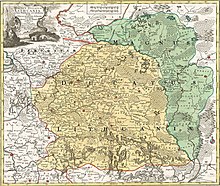
Magnus Ducatus Lithuania, Tobias Lotter, 1780

Until 1793 Belarus belonged to Poland-Lithuania (here in the borders of 1619)
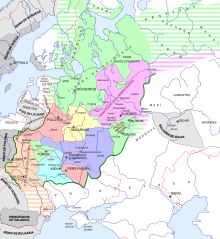
Rus Principalities in the Union of Kievan Rus
Questions and Answers
Q: What is the capital of Belarus?
A: The capital of Belarus is Minsk.
Q: When did Belarus become independent?
A: Belarus became independent on 25 August 1991.
Q: How many people live in Belarus?
A: Approximately nine million people live in Belarus.
Q: What countries border Belarus?
A: The countries that border Belarus are Russia, Ukraine, Poland, Lithuania and Latvia.
Q: What percentage of its land area is forested?
A: Over forty percent of its 207,600 square kilometres (80,200 sq mi) is forested.
Q: What religions are practiced in the country?
A: The main religion in the country is Russian Orthodox Christianity and Roman Catholicism has a much smaller following.
Q: Who was president of Belarus from 1994 to 2020?
A: Alexander Lukashenko was president of Belarus from 1994 to 2020.
Search within the encyclopedia
